May 9, 2022
Stairway to rebirth: Taking on the steps of Mt. Haguro, Yamagata
Gallery - Mt. Haguro, Dewa Sanzan, Yamagata Prefecture
In a land where mountains are revered, the Dewa Sanzan - the collective name of the three mountains of Haguro, Gassan, and Yudono - are considered among the most sacred peaks in Japan.
For over a thousand years, pilgrims seeking a kind of rebirth have been drawn to Yamagata Prefecture in northern Japan, to journey and meditate among the peaks of the Dewa Sanzan.
These are the Yamabushi - white-robed mountain ascetics who practice a Spartan form of mountain worship known as Shugendo. For some 1,400 years the Yamabushi have been trekking, fasting, meditating and shivering under frigid waterfalls in an effort to become as one with the spirits of the Dewa Sanzan and to emerge from the mountains reborn.
In order to be reborn one has to pass from this earth. Accordingly, for the Yamabushi, to enter the mountains of the Dewa Sanzan is to leave behind this world and enter another. It’s a world in which the self as one knows it, is dead - hence the white “shiro shozoku” robes, which are said to represent having passed from this earth.
[Watch the video on the City-Cost YouTube channel]
The three mountains of the Dewa Sanzan line up approximately north-south in Yamagata’s Shonai region.
Mt. Haguro, the northernmost of the peaks, and at 414m the most diminutive by some distance, is believed by the Yamabushi to represent the world of the present. Journeying south, Mt. Gassen (1,984m) is the world of the past - the land of the afterlife. Mt. Yudono (1,500m) represents the world of the future. A full pilgrimage starts at Mt. Haguro, then summits Mt. Gassan and Mt. Yudono (in that order) before returning to make a descent of Haguro’s famous stone stairway.
Japan’s celebrated poet wanderer Matsuo Basho tackled the peaks of the Dewa Sanzan during his travels through northern Japan. A few pages and a handful of haiku are given to Basho’s experiences in the province of Dewa in his book, The Narrow Road to the Deep North (1689).
While Basho didn’t mention anything of a sense of rebirth his words do perhaps reflect some of the hardships the Yamabushi might endure.
“I reached the summit, completely out of breath and nearly frozen to death,” the haiku master wrote of his experiences on Mt. Gassan.
Basho walked, sailed along rivers, and rode the occasional horse to reach the Dewa Sanzan from his home in Tokyo.
Our journey to the Dewa Sanzan in early November was far less arduous - an hour-or-so’s flight from Tokyo’s Haneda Airport to Shonai Airport a few kilometers north of the city of Tsuruoka.
So this is where the modern pilgrim’s journey to rebirth starts, in the confines of a simple business hotel and over a spitting grill of yakiniku in an izakaya in downtown Tsuruoka. Outside in the Tohoku autumn chill Basho’s deep north was blanketed in a heavy veil of darkness.
Morning, and on the road east to Mt. Haguro and the rest of the Dewa Sanzan our rental cut a path across the broad plain carpeted with rice fields - a buffer zone between urban and spiritual worlds. To the north, the great bulk of Mt. Chokai in the distance marked the border with Akita Prefecture.
At the edge of the plain we slowed to a gentle roll in order to gawp up at the Hagurosan Ootorii which at 20m high and 15m wide is the largest torii gate in the Tohoku region. It’s also a newcomer to the Dewa Sanzan scene, having been erected in 1929.
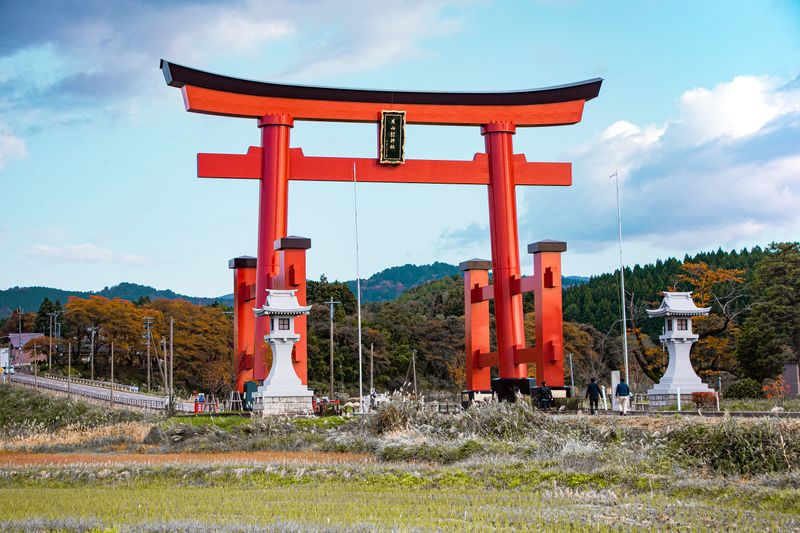
(Hagurosan Ootorii marks the approach to the Dewa Sanzan.)
The road to the mountains is uphill from here. This is the slope of God's way, or “Kamiji-zaka.”
Mt. Haguro is the only mountain of the Dewa Sanzan which remains open year-round, with heavy snowfall keeping Gassan and Yudino off limits during the winter. This, along with Haguro’s comparatively diminutive stature, makes the mountain the natural choice for those who would prefer to take only a tentative dip into the Yamabushi experience. Indeed, in what might appear as something of a spiritual and marketing sleight of hand, it’s said that the gods of Gassan and Yudono also migrate to Haguro for the winter where they take up residence at the Sanjin Gosaiden shrine at the summit.
Whatever the season and whatever the level of commitment, it’s at the foot of Mt. Haguro where the Yamabushi's journey to rebirth begins. And while it’s likely that nothing could prepare the serious pilgrim for the hardships of a true Yamabushi experience, equally so there’s little we can write here to prepare even the most spiritually cynical visitor for just how beautiful the climb up Mt. Haguro is. Let’s just say that there’s something in the air here.
Not everyone makes the climb up Mt. Haguro though - a climb which centers on an ancient 1.7km stone path made up in large part of 2,446 steps.
We almost don’t want to say it but a top-down approach is possible courtesy of a toll road which loops around the southern slopes of the mountain before making its bid for the summit and a parking area replete with shops and toilets.
In an effort to have visitors tackle the stone stairway and take more time to be at one with the mountain, the priests of Dewa Sanzan Shrine along with a local tourist organization launched the Ishidan Mode (石段詣) initiative in June 2021. The initiative was aimed at encouraging visitors to make the complete “stone stairway pilgrimage” by having them register via QR codes and offering gifts upon completion of their journey.
“In the past, people used to visit the shrine via the stone stairway, but now there is a toll road connecting to the top of the mountain. Many worshippers, perhaps pressed for time, go up to the five-storied pagoda, but then drive to the top of the mountain instead of walking up the stone stairway," Toshiki Yoshizumi, the chief priest of Dewa Sanzan Shrine told Asahi Shimbun during the launch of the initiative.
“The approach to the shrine is a place where you can sharpen your senses and feel the energy from nature in the wind and in the scent of moss. Visitors from overseas spend five to six hours to go up there," he said.
The impressive mass of Zuishinmon gate marks the entrance to the mountain and the spiritual world beyond. We felt the division like night and day. Whatever world this is on Mt. Haguro, it’s a quite beautiful one - and peaceful, too, at around 8am.
After passing through Zuishinmon the stone path begins, making a serene descent, flanked by the mountain’s famous and towering cedar trees, toward the waters of the Harai River.

(Descending the stone stairway after Zuishinmon, Mt. Haguro, Dewa Sanzan.)
The Yamabushi perform purification rituals in the waters of the Haraigawa - “river of purification” - before pressing on with their journey.
Near where the stone path meets the Haraigawa, water from the Suga-no-taki falls pours into the river. At the base of the falls, and in a state of permanent damp, is a diminutive shrine sharing the name of the river. Here are enshrined the spirits of four gods whose speciality it is to swallow, blow, exorcize and release into the waters evil spirits.
The Haraigawa is traversed by the pretty Shinkyo Bridge, the vermillion paint job of which makes for a brilliant contrast to the surrounding greens. At 22 meters long and 4.4 meters wide the bridge is made entirely of cedar from Mt. Haguro.

(Shinkyo Bridge, Mt. Haguro, Dewa Sanzan.)
A purification ceremony was held here in May 2021 to mark the completion of the first comprehensive renovations to the bridge in over 40 years.
After crossing the bridge and on the approach to the Haraigawa Shrine is the Shimekake-zakura, a cherry tree the branches of which are adorned with numerous shime.
The shime is a kind of paper necklace (for want of a better description) worn by Dewa Sanzan pilgrims to create a sacred boundary around the self. Pilgrims would hang their shime on the tree while undergoing purification rituals in the Haraigawa and finally after returning from their journey across the Dewa Sanzan before re-entering the “real” world.
Many of the more casual pilgrims on Mt. Haguro will have paid around 1,000 yen for their shime. It’s perhaps understandable then that they give the Shimekake-zakura a wide berth.
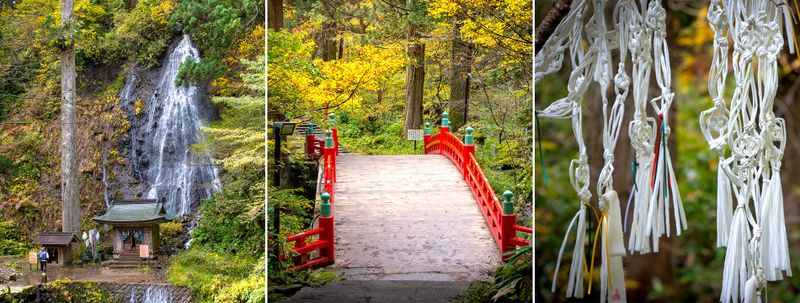
The going is comfortable after crossing the Shinkyo Bridge with Haguro’s stone path barely at an incline. Just off the main path stands the Jiji-sugi or “Grandpa Cedar” looking proud as punch with a shimenawa rope tied around its trunk. Jiji-sugi is estimated to be over 1,000 years old and is thought to be the oldest of the cedars on Mt. Haguro. And at 43m, the tallest, too.
Beyond Jiji-sugi and seemingly doing its best to blend in with the rest of the cedars is the magnificent Haguro Five-storied Pagoda.
At nearly 30m high the pagoda is a quietly spectacular sight. Quietly because it has forgon the need for any kind of paint job presumably in an effort to make the structure appear at one the with spirit and nature of the mountain.
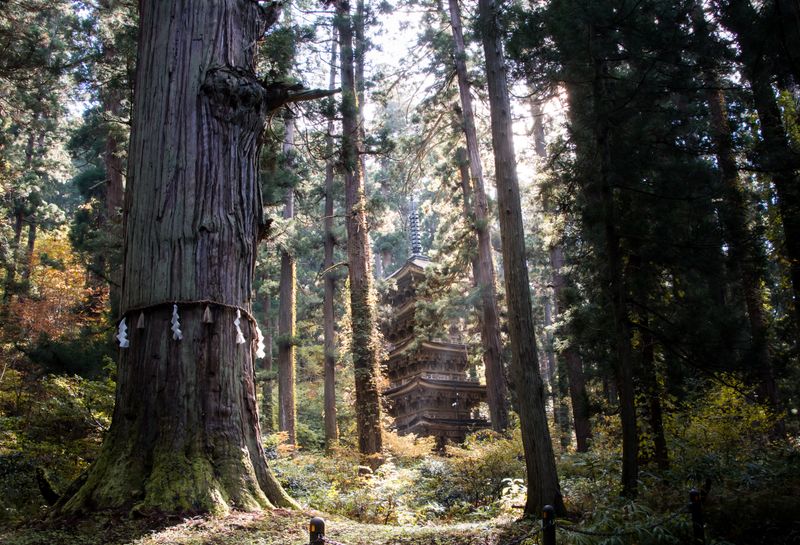
(Jiji-sugi “Grandpa Cedar” and the Five-storied Pagoda, Mt. Haguro, Dewa Sanzan.)
The long eaves of Haguro’s Five-storied Pagoda are said to resemble a swan taking flight. Beautiful imagery perhaps, but the design is not so practical given the often heavy snowfall in this region of Japan. In January 2021 a team from Dewa Sanzan Shrine (which manages the pagoda) was called into action to clear over a meter of snow from the pagoda’s roofs. In heavier years up to 1.7m of snow has collected on the roofs, according to local media.
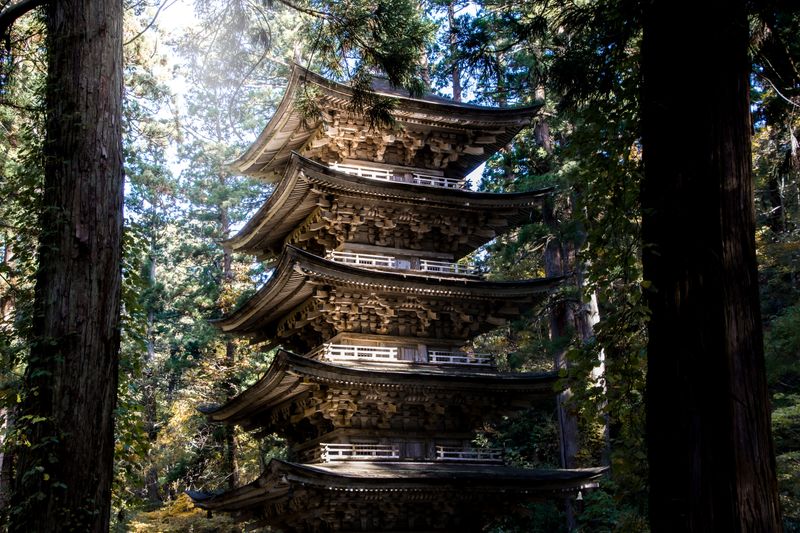
(Five-storied Pagoda, Mt. Haguro, Dewa Sanzan.)
Haguro’s stone stairway really gets into gear just after the pagoda. In fact, rounding the corner from one of the pagoda’s two approaches the stone stairway pilgrim is presented with the sight of Ichi-no-zaka - the first of the stairway’s three viscously steep slopes, and arguably the kindest.
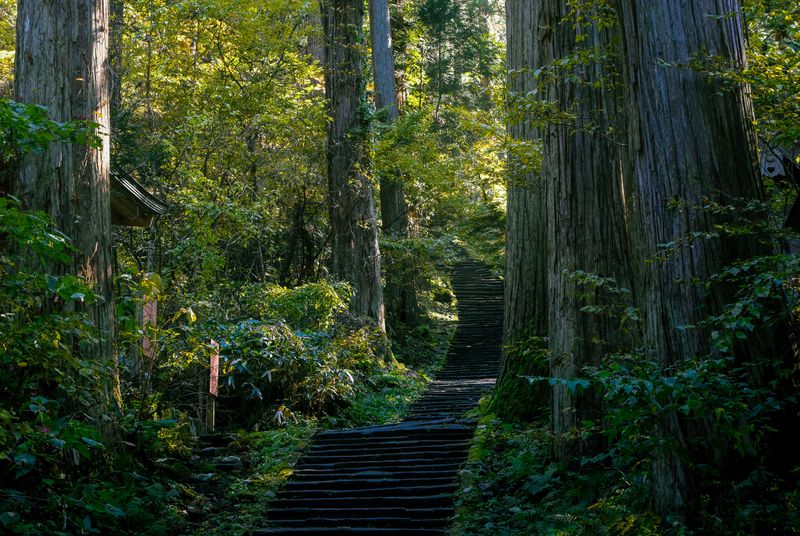
(Ichi-no-zaka - the first of Mt. Haguro's three steep slopes.)
It’s perhaps little wonder then that the faint of heart and creakier of knees at this point favors a hurried u-turn to the parking lot, their car, and the toll road to Haguro’s summit.
In all seriousness though, all and sundry was making the climb during our visit, which at a steady pace can be completed in an hour or so. Some were even taking it at jog.
It’s worth taking your time though. The scenery on Mt. Haguro is truly splendid with worn stones, centuries old cedars and mountain-weathered monuments to gods all lending to the excitingly ancient and otherworldly mood.

The second of the stone stairway slopes is particularly stiff - Ni-no-zaka. Some of the younger climbers seemed to make light work of what, in some sections, is surely only a few degrees away from being a ladder. For climbers of an older vintage though, Ni-no-zaka is very much hands-on-hips territory.
Many Haguro pilgrims (presumably of the more casual kind) choose to reward their conquest of the slope with a drink and a snack at the Ni-no-zaka Teahouse, the operators of which must have legs as thick as tree trunks.
It was somewhere after topping the slope that we picked up the trail of a group of Yamabushi heading up the mountain. We could hear them from a mile off courtesy of their leader blowing into a horagi conch shell. Even the mighty cedars can’t prevent the haunting sound of the Yamabushi’s horagai echoing across the mountain.
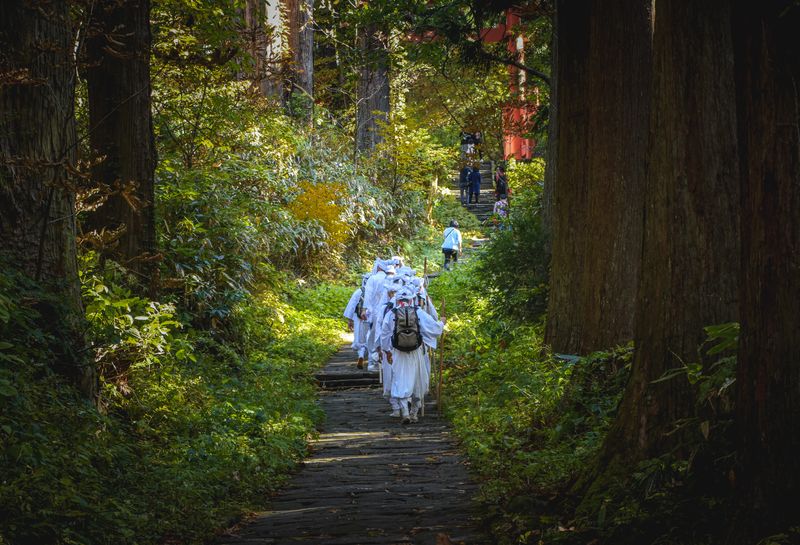
(A group of Yamabushi on the stone stairway to Mt. Haguro's summit.)
The Yamabushi - wrapped in the white robes of the deceased while sporting branded rucksacks - made swift progress along the stone path which after Ni-no-zaka levels out as it passes through a quite stunning avenue of cedars.
San-no-zaka - the third slope - is the stone stairway’s final throw of the dice to make you suffer before reaching the flat-topped summit of Mt. Haguro and the precincts of the Sanjin Gosaiden shrine. Any suffering might be eased though, by the sight of the beautiful and large torii gate which frames the end of the climb.
Around the upper reaches of San-no-zaka we dined at the Haguroyama Sanrosho Saikan, a former temple and now lodging used by the Yamabushi.
On the menu at Saikan was Dewa Sanzan shojin ryori, simple dishes suitable for the ascetic with ingredients made up primarily of local mountain vegetables. The meal we were served seemed a little on the lavish side though, at least in its entirety. It must have covered 10 dishes, including rice and miso soup. The meals eaten by the Yamabushi are actually far more Spartan, comprising just two or three of the dishes that came with our meal.
The Dewa Sanzan Shrine priest who accompanied us at Saikan said of the shojin ryori dining experience that we were “taking in the power of the mountain.”
The priest’s description certainly was romantic but we have since rather enjoyed the more frank description from Tim Bunting, a Dewa Sanzan Shrine Yamabushi and curator of the informative Dewasanzan.com. Bunting wrote in Dewasanzan.com of the roots of Dewa Sanzan shojin ryori:
“Yamabushi ate what they could for survival during their rigorous training. From nuts, to roots, grasses, bamboo shoots, flowers, and mushrooms, Yamabushi ate anything edible on the mountains.”
Taking a bottom-to-top approach on Mt. Haguro meant our experience of the mountain was punctuated by paying our respects at Sanjin Gosaiden shrine.
Sanjin Gosaiden is distinct for two things - it’s where the gods of Mt. Gassan and Mt. Yudono like to “winter,” and its thatch roof, at 2.1m thick, is the thickest thatch roof in Japan. The roof is in a constant state of maintenance, which amounts to it being replaced every two years, a Dewa Sanzan Shrine priest told us after our prayers.
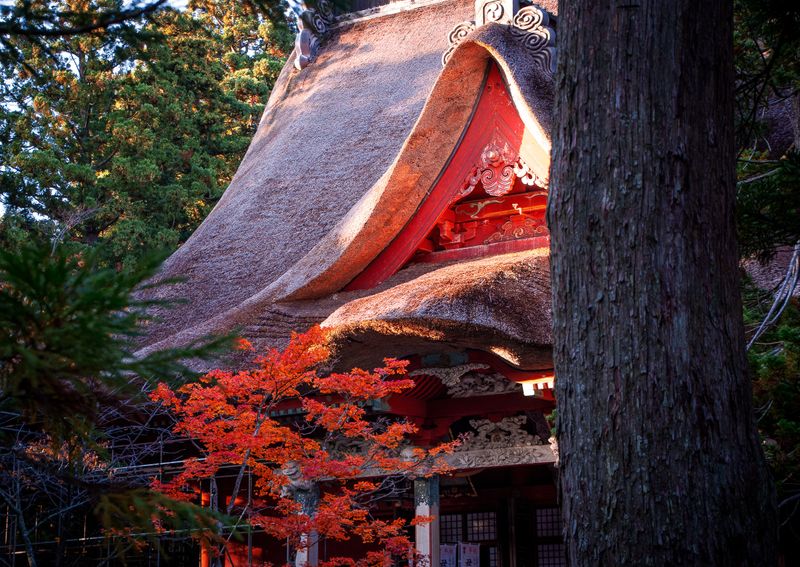
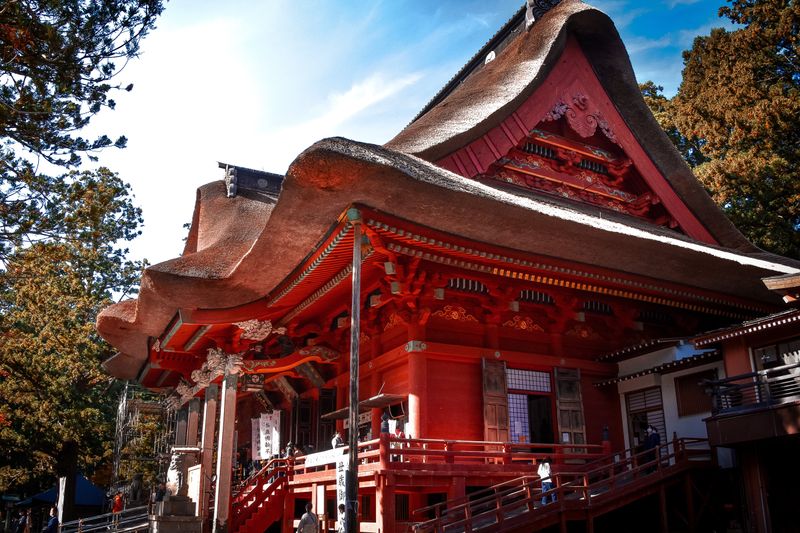
(At 2.1m thick the roof of Sanjin Gosaiden is said to be the thickest thatch roof in Japan.)
The expansive grounds of Sanjin Gosaiden, replete with hurried worshippers, instabae photo spot, and nearby vehicular transportation waiting patiently, actually came as rather a shock after having experienced the kind of secret-garden world of Haguro’s stone stairway. The feeling of rebirth at this point was rather usurped by a desire to return to the quiet of the mountain slopes and the shelter of the giant cedars. A return to the womb.
But this is just the beginning. The true Dewa Sanzan pilgrim is yet to confront their past and contemplate their future before returning to Haguro and re-entering the world, reborn.
Like many others who make it here though, our journey would end before it could continue. We were to take the rental and the toll road as our way off Mt. Haguro, for reasons of work and logistics. On the way down the mountain we pulled over at a quiet parking area to look south and contemplate the rest of the Dewa Sazan. Maybe we felt the lack of having not pressed on with the pilgrimage laid out before us.
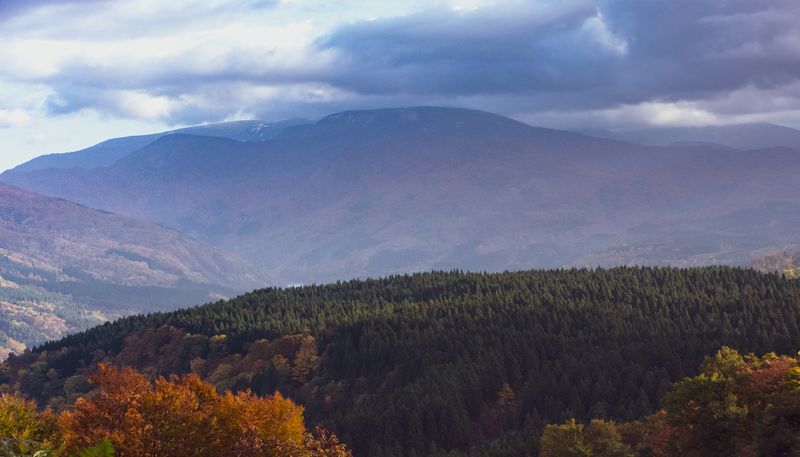
(The view south from Mt. Haguro toward the rest of the Dewa Sanzan.)
Mt. Haguro is an experience of its own though. Matsuo Basho certainly seems to have thought so, and we’d have to say that we concur. In The Narrow Road to the Deep North, Basho wrote of Haguro:
“Indeed the whole mountain is filled with miraculous inspiration and sacred awe. Its glory will never perish as long as man continues to live on earth.”



0 Comments